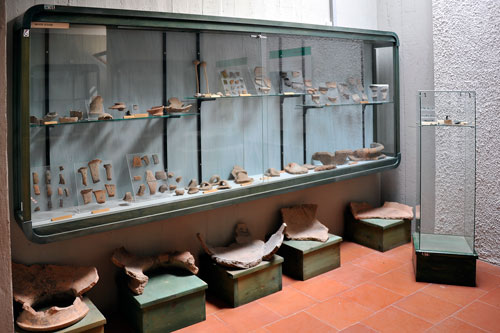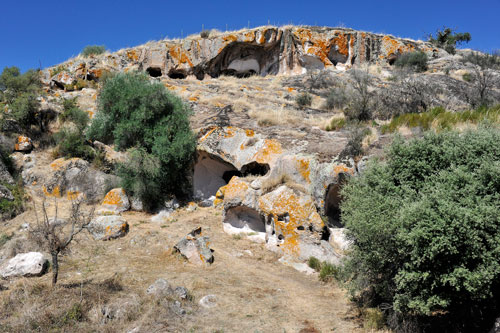Ittireddu and surroundings
map of Ittireddu and surroundings with the marked sightsiten
 The village, which has about 600 inhabitants, has numerous interesting prehistoric sites in its vicinity.
The village, which has about 600 inhabitants, has numerous interesting prehistoric sites in its vicinity.
Many of the finds made there are exhibited in the Museum of Ittireddu.
The museum is located right next to the municipal administration and is definitely worth a visit.
There is also an ethnographic exhibition in the community’s council chamber, showcasing handicraft tools, costumes, and typical Sardinian products.
Some sights outside the village are not easy to find. Although they are all signposted along the main road, oriantation the terrain can be challenging.
To make things a bit easier, you can purchase a map at the museum and have the exact locations shown to you on an aerial photograph.
The easiest to find are the Sant’ Elena ruins, the Domus di Partulesi, and the Roman bridge Pont’ Ezzu. To reach these, simply follow the road on which the museum is located, heading out of the village. (see map)
Domus di Monte Pira

The rock-cut tombs known as “Domus de Janas” (Fairy Houses) are well hidden, even though there is a signpost on the main road. Follow this sign, and it’s best to leave your car at the end of the paved road and continue on foot.
The path soon leads up a hill, from where you will have a wonderful view of the pastures of Logudoro. Here, turn left onto a small rocky plateau. If you look closely, you will discover several holes in the rocky ground, mostly overgrown with thorny shrubs.
These inconspicuous openings are the entrances to the “Domus de Janas.”
Sant’ Elena Church Ruins

Shortly after leaving the village, on the right side of the road, stands the ruins of a Byzantine church. The structure dates back to the 7th century and was built using trachyte and red-black volcanic rock from the surrounding area.
Domus di Partulesi
 A bit further past Sant’ Elena, on the right, you will see a rocky hillside that is perforated like Swiss cheese.
A bit further past Sant’ Elena, on the right, you will see a rocky hillside that is perforated like Swiss cheese.
About 30 rock-cut tombs (Domus de Janas) were created here.
The site is open for visitors.
If you are interested in exploring the interiors of these tombs, you should bring a flashlight.
Roman Bridge Pont’ Ezzu

A good distance outside of Ittireddu, the remains of a Roman bridge can still be found—one of the very few purely Roman structures still existing in Sardinia. Two arches of the bridge remain, which likely originally spanned the Riu Mannu. Today, this stream flows about 50 meters further west.
Contrary to some guidebook descriptions, the bridge can also be reached by car.
Santa Croce Church and Quarry

In the eastern part of Ittireddu stands this beautiful Byzantine church from the 6th century.
About 600 years later, it was renovated in the Romanesque style.
If you walk a little further out of the village from here, you will pass by the site of the Ittireddu quarry.
The former volcano Monte Lisiri was essentially cut in half to extract the porous volcanic rock.
Dolmen Sa Coveccada

The dolmen is the largest in all of Sardinia and one of the largest in the Mediterranean region.
It is assembled from massive stone slabs and stands about 3 meters high. The structure likely served as a family tomb.
After the multi-ton capstone broke, the dolmen was at risk of destruction. In 2010, significant efforts began to secure and restore the structure.
Since then, the dolmen has been covered and is thus easily visible from afar.
How to get there: The dolmen is best signposted from the direction of Mores.
First, head towards Bono, cross the railway line, and about 3 km after the railway crossing, turn right.
Follow this narrow paved road for another 3 km until a turnoff to the right towards a farmhouse. From here, continue on foot down the hill, and after a few minutes, you will reach the dolmen.
